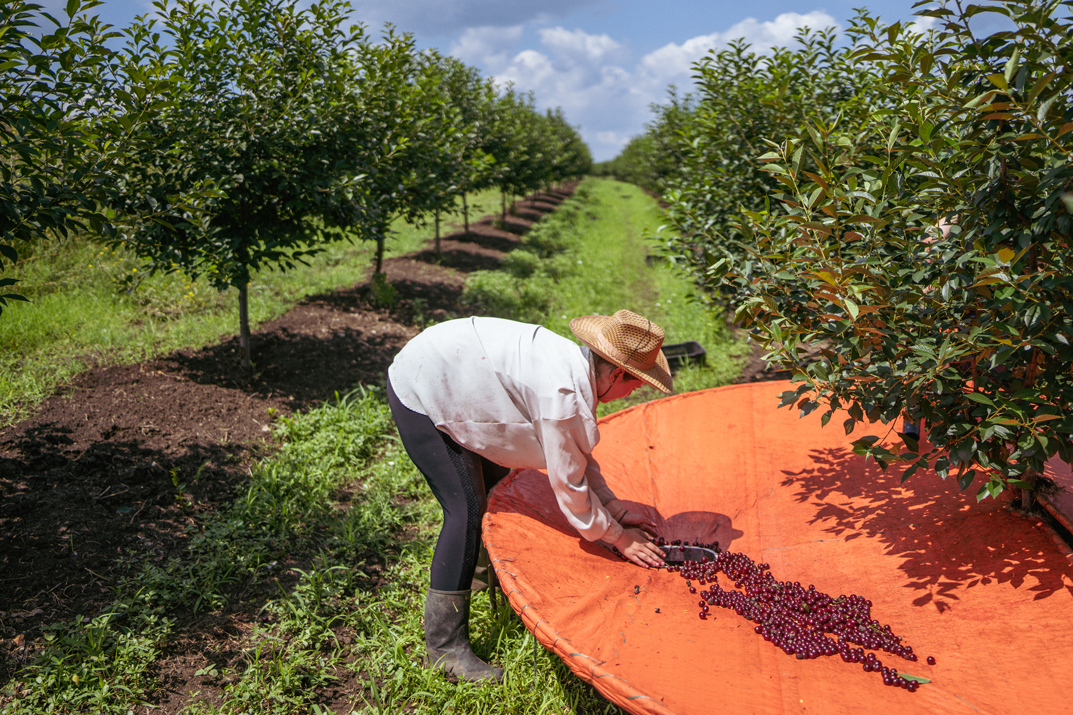
©FAO/ Uroš Arsić
Often referred to as “red gold”, Ariljska Malina, a plump, vibrantly coloured raspberry, is one of Serbia’s crown jewels. This local berry is a beloved delicacy, whether eaten freshly picked, baked in cakes, dipped in chocolate or turned into juices, preserves or other culinary delights.
Today, the Arilje region of Serbia produces around 25,000 tonnes of the fruit each year, which is mostly exported to Western Europe. Farmers in the region developed a now decades-old growing and harvesting technique – coined the “Arilje method” – that, along with the area’s microclimate, contributes to the raspberry’s taste and quality. This production method involves growing the bushes on a trellis and removing the first shoots to allow ample sunlight for good ripening. The hand-picked raspberries, once cleaned, can be frozen immediately preserving their freshness.

Raspberry production was introduced into this area of southwestern Serbia following the Second World War and was championed by local professor and writer Dobrilo Nenadic, who invested considerable time and energy into promoting the fruit. People started growing the raspberry on small plots and soon after Ariljska Malina became the area’s only commercial product, driving the area’s economic development.
Ariljska Malina is also one of more than 9,000 geographically protected foods worldwide – making the fruit as inseparable from Serbia as Parmigiano Reggiano cheese is from Italy or Darjeeling Tea is from India.
Another fixture in Serbian cuisine is the renowned sour cherry, Oblačinka, from Serbia’s southern Oblačina region. Smaller and darker than other varieties, the Oblačinka sour cherry strikes a balance between sweet and tangy and is packed with nutrients, vitamin C and antioxidants.
Come late spring, the landscape in this region takes on a reddish hue from trees loaded with ripened cherries, ready to be shaken from their branches.
Nearly all are coming from small orchards run by family farmers who have passed down their love of the sour cherry and technical know-how from generation to generation.
Serbia’s Ariljska Malina and Oblačinka from Oblačina sour cherry, like the country’s Leskovac homemade ajvar (a red pepper spread), Zlatar cheese and Fruska Gora linden honey, received national geographical indication (GI) status within the last decade or so.
This official GI label links a specific, quality product to its place of origin, protecting the product’s reputation and authenticity while guaranteeing its quality and origin to consumers.
Hence, only raspberries grown in Arilje’s microclimate conditions and complying with the rigorous production specifications of Ariljska Malina can use the officially protected name, for example.
The GI label also ensures that the Ariljska Malina raspberry and Oblačinka from Oblačina sour cherry producers of today – and tomorrow – will be able to grow and hand-pick the fruit the same way their ancestors did.
Helping producers gain an edge in the market
For both the Ariljska Malina and Oblačinka from Oblačina sour cherry, the Food and Agriculture Organization of the United Nations (FAO) and the European Bank for Reconstruction and Development (EBRD) worked closely with Serbia’s Ministry of Agriculture, Forestry and Water Management and the Intellectual Property Office to assist Serbian producers and processors in developing production specifications or registering the fruits as GIs.
With financing from the European Union and the Government of Italy through the Central European Initiative, the project provided support ranging from strengthening producer organizations and organizing study tours to sharing advice on GI laws and legal frameworks. FAO and EBRD also offered training on GI certification, promotion, quality control and protection against imitations. This ensures that GI products can get an edge in a crowded market.
A study by FAO and EBRD, which analysed nine products, found that origin-linked labels could translate into a price premium of between 20 and 50 per cent compared with non-GI-labelled products.
Guardians of Reputation
Receiving the GI is a major accomplishment – the result of a lengthy and involved process. However, its enduring success hinges on a strong campaign to protect and promote the certified fruits.
FAO and EBRD support to producers helps ensure continued promotion and protection of these products while building strong governance.
The Sour Cherry Association, for example, helps ensure internal quality controls and traceability. It also strengthens producers’ promotion, marketing, negotiating power and relationships with suppliers and buyers.
In addition, it encourages producers and processors to innovate and create new product lines, like dried cherries and organic cherries, under the GI label.
In a similar vein, members of the Ariljska Malina Association work together to protect and promote the raspberry, helping family-owned companies diversify their products to tap into new markets at home and abroad.
One company even produces delicacies like freeze-dried raspberries dipped in fine chocolate and is working on selling GI-labelled fresh raspberries directly to supermarkets and consumers.
According to Aleksandar Obradović, a sales manager at one of the Association’s member companies, the GI label is shorthand for a fruit that meets all safety standards and is consistently good quality.
Championing foods with a backstory
The world is increasingly globalized. Habits and lifestyles change, but food traditions die hard. The demand for healthy, nutritious food is on the rise, as is the demand for local, traditional foods. Countries understand this attraction and are building sustainable agritourism industries – from gastro routes to food festivals – that champion their unique gastronomic traditions and natural beauty.
Successful GIs can breathe new life into rural communities, creating jobs, especially for young people, and inspiring local producers to protect the agricultural biodiversity that makes their GI products distinct.
Serbia’s Ariljska malina and Oblačinka from Oblačina sour cherry are delicious nods to all that, and a reminder that keeping these traditions alive for future generations is a worthy investment and endeavour.
– global bihari bureau





